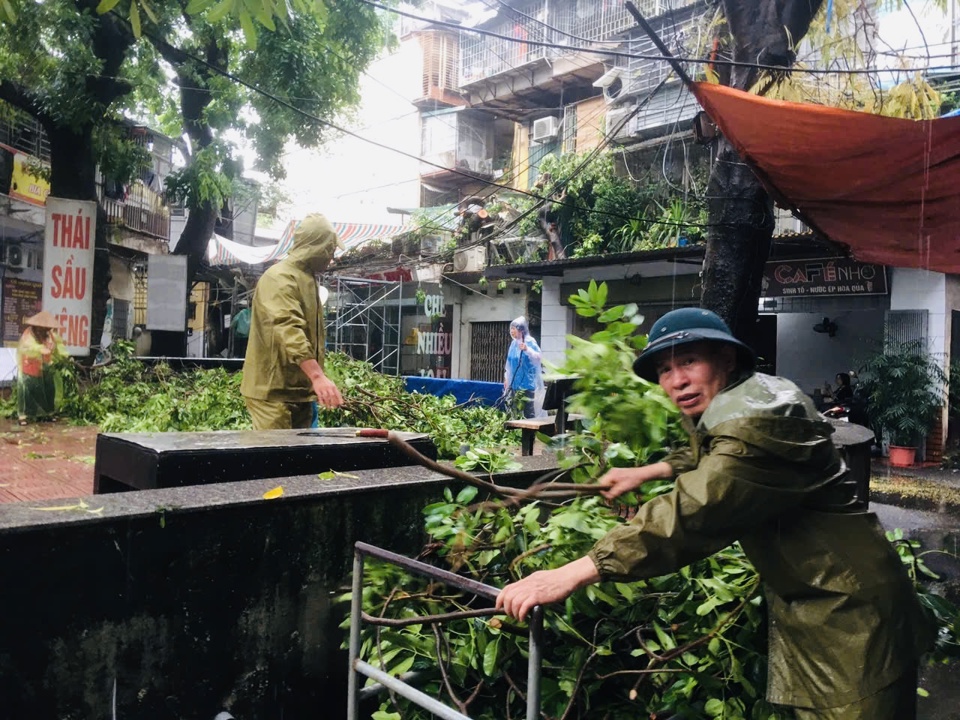PUBLIC SERVICES

Areas at risk of landslides or flooding, particularly along transportation routes, will be closely monitored, and traffic diversions will be implemented where necessary.
The Hanoi People's Committee on September 11 issued an official directive, increasing recovery efforts in the wake of Typhoon Yagi (Typhoon No. 3), which recently caused significant damage across the city. Official Dispatch No. 2993/UBND-DT emphasizes urgent inspections, repairs, and measures to ensure the safety of buildings and urban infrastructure throughout the capital.

Removing fallen tree branches in Thanh Xuan Bac Ward on September 11, following the storm. Photo: Hong Thai
In response to the aftermath of the typhoon, Hanoi's authorities are taking swift action to address damage to public facilities and protect residents. The directive prioritizes the inspection of structural integrity in key buildings, such as schools, hospitals, apartment complexes, and other high-traffic public spaces. Special attention will be paid to inspecting windows, balconies, hanging fixtures, walls, roofs, and technical systems, such as electrical and water infrastructure, with immediate repairs to be carried out where necessary.
For buildings that sustained structural damage or show signs of instability, repairs and safety evaluations must be completed before they can be used again. This is particularly important for older apartment complexes, which will be evaluated according to Directive 05/CT-TTg, issued by the Prime Minister in 2016, to assess the safety of aging urban residential and public structures.
Authorities have also called for the removal of damaged billboards, roof tanks, glass facades, and other dangerous structures, as well as the repair of any shaky or unstable elements. Inspections will be conducted on ongoing construction projects, and any damaged machinery or equipment will be dismantled or repaired. Before work resumes, construction sites will be assessed to eliminate safety risks.
In addition to these measures, the directive stresses the importance of adhering to national safety standards, especially when working at heights, handling electrical systems, and assembling or dismantling construction components.
To prevent flooding and ensure the smooth operation of the city's infrastructure, drainage systems will be cleared and monitored. Water control gates and pumping stations will be checked regularly to increase drainage capacity. Damaged streetlights, traffic signs, and other urban infrastructure will be swiftly repaired. Meanwhile, areas at risk of landslides or flooding, particularly along transportation routes, will be closely monitored, and traffic diversions will be implemented where necessary.
Residents living in areas prone to landslides, especially near hills, rivers, or downstream regions, will be relocated to safer areas if needed. Additionally, efforts are underway to remove fallen trees and debris, with all available resources being mobilized to ensure public safety.
The People's Committee has tasked the Director of the Department of Construction with leading and coordinating recovery efforts. Reports on progress are expected to be submitted by the end of September.
Relevant departments, including Construction, Industry and Trade, Transport, Agriculture and Rural Development, and project management boards, are responsible for guiding maintenance and construction units to implement these safety measures. Progress reports must be submitted to the Department of Construction by September 20, 2024.
Emergency teams from the departments of Transport, Public Security, the Capital Military Command, and local authorities will continue to monitor and promptly address any storm-related incidents to ensure public safety and restore order in the city.
These concerted efforts are aimed at ensuring a swift recovery from Typhoon Yagi and safeguarding Hanoi’s infrastructure and residents from further harm.
Ngoc Mai